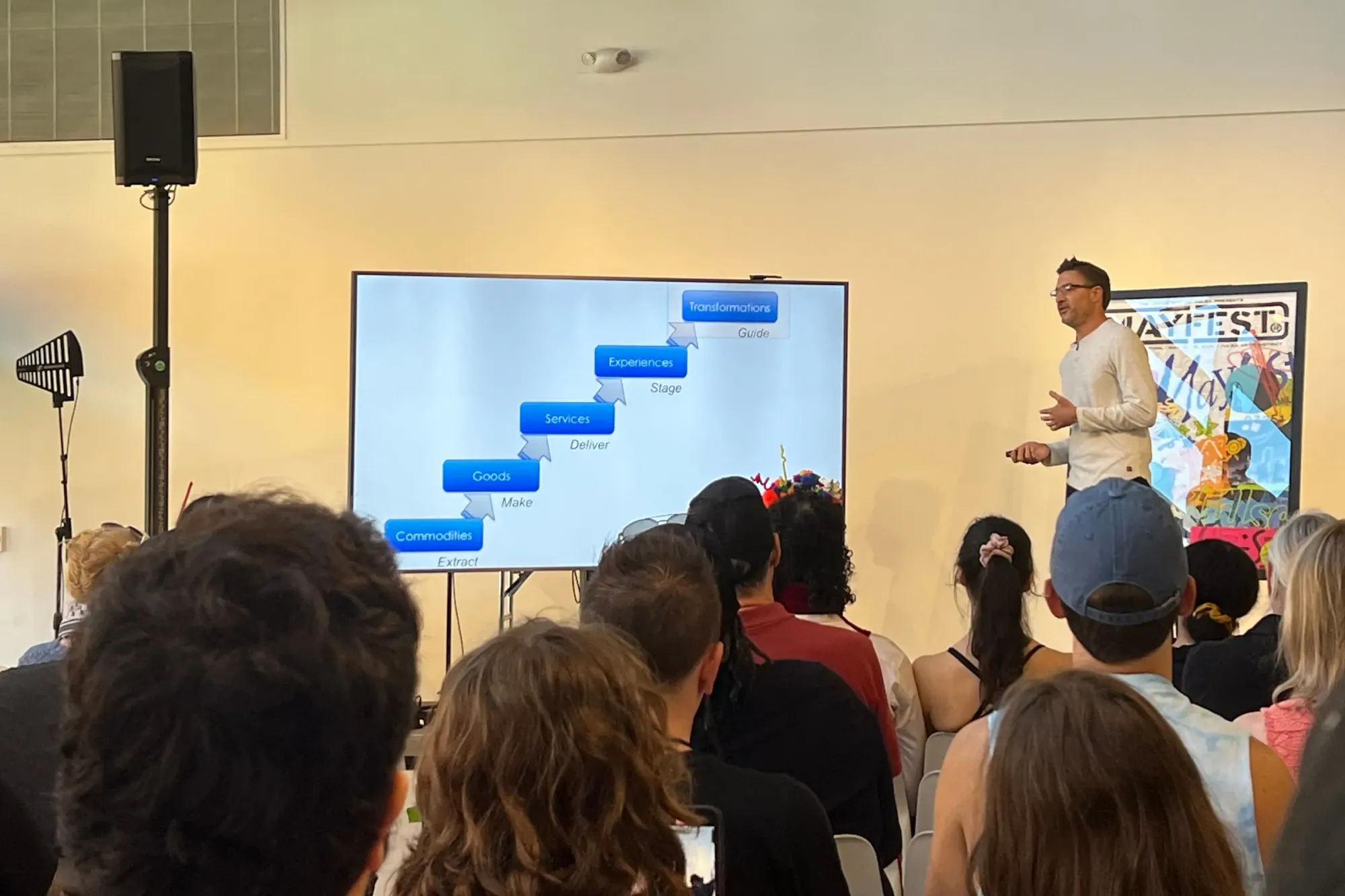Mayfest Keynote Address: “The Value of Creativity in These Transformative Times” by Meow Wolf’s Vince Kadlubek
101 Archer
Tulsa
May 11, 2024
“There has never been a creative company that has stayed cool.”
That sobering truth came from Meow Wolf cofounder and CEO Vince Kadlubek during the ending Q&A of his Mayfest keynote speech “The Value of Creativity in These Transformative Times.”
Kadlubek is, effectively, the kingpin of immersive art in the U.S., having led Meow Wolf during its days as a scrappy, recurring pop-up in 2008 and helmed its growth into a multi-city brand known for the promise of its tagline: “We Open Portals of Possibility.”
The particular irony of his statement was heightened by its delivery inside 101 Archer (the Hardesty Arts building), the former home of nonprofit arts center AHHA Tulsa, a facility focused on interactive and immersive artworks, which shuttered unexpectedly in November 2022. (AHHA Tulsa was also the former presenter of Mayfest. The building and festival are now owned by the University of Tulsa.)
He opened his talk praising the “connective tissue” of Tulsa’s arts community and chronologically explaining how something as unusual as Meow Wolf happens. In short, a collective of young artists in Santa Fe, feeling stifled by the lack of welcome from a more traditional arts community, used their pent-up energy to create pop-up events, initially in warehouse spaces transformed by visual art created from found objects.
“Ultimately, we were building forts,” Kadlubek said. “Adults wanting to be kids.”
After several years of the events, the arts collective members did what everyone does — grew up a bit. Kadlubek said the passion project became a “weird obligation” and realized that for it to be sustainable, it would also have to turn into a legitimate business that employs artists. A couple of calls to George R.R. Martin (really) and $2.5 million in debt later, Meow Wolf’s permanent House of Eternal Return opened in Santa Fe in 2016, to 450,000 visitors in its first year.
Meow Wolf now has four museums, for lack of a better word, across the country with more opening soon, and employs hundreds of people, including 350 full-time artists. It’s been a lightning-quick trip along the subculture-to-corporation pipeline for the company, and Kadlubek was frank in his assertions about art in the context of capitalism, touching on everything from the loss of humanity in stressful leadership positions to what it actually looks like to build art, at huge scale, in order to create jobs and make money.
“The relationship between a brand and its audience is consumption,” he said; I’d argue that extends on a more direct level to the relationship between art and viewer as well. Making art in order to make a living is a subset of capitalism, whether any of us like it or not.
What works for Meow Wolf uniquely, then? Paraphrasing Joseph Pine’s The Experience Economy—which he read while trying to retroactively understand Meow Wolf’s success, not to plan it — Kadlubek discussed exploration and discovery as keys to transformative experiences, as well as the neuroscience behind keeping people’s attention in positive ways. The context of the unknown is essential and also explains the virality of the “portals” inside the original Meow Wolf location. The refrigerator and dryer inside the House of Eternal Return are, literally, points of entry into unexpected art worlds. People are excited to pay for that type of experience because it is so unexpected.
I appreciated Kadlubek for his admission that realizing why it worked so well came later, in tandem with his ability to discuss business in the same breath as the fantastical. The talk’s title lifted up the “value” of creativity, and that is two-fold: its value as transformative experience to artist and patron, and its sustainable monetary value when turned into for-profit art.
Asked about the possibility of Meow Wolf coming to Tulsa — by a listener who mentioned AHHA’s closure — Kadlubek said he was open to the possibility but said they’re targeting coastal areas first. He then steered his answer toward projects like Oklahoma City’s Factory Obscura and Hopscotch (San Antonio and Portland), both of a Meow Wolf mindset but locally founded, funded and led.
He was unflinching in the face of effusive praise as the Q&A wound down. I was pleasantly surprised to hear as many questions about art as about the business of selling it, with several people asking how a company like Meow Wolf is able to grow without dismissing its core tenets. Kadlubek was not willing to say outright that there is no compromise in that regard, even at Meow Wolf, but spoke of an in-progress hope about the continuation of its trailblazing origins in the context of art in the U.S. and beyond.
“I hope that we’re never not surprising,” he said about brand identity versus growth. “I think we have a shot at being interesting for a while.”
Next at 101 Archer: Deep Greenwood Community Read, “Imaginings: The Futures of Greenwood,” May 30






